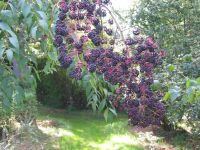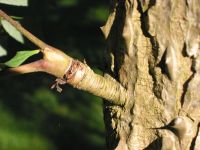Chinese Angelica-tree - Aralia chinensis
English name:
Chinese Angelica-tree
Scientific name:
Aralia chinensis
Family:
Araliaceae (Ginseng family)
Height:
up to 5 m. in Hørsholm Arboretum
Flowering:
August
Range:
China
 |
 |
 |
The Aralia chinensis in the picture can be found by the Lake road of the Arboretum, in square 1014 position 2412
Plant description:
One has to be brave to have a plant of the month for a plant where one is not sure what the name should be. But this plant is so spectacular and I could not help but present it. Here I am using the name Aralia chinensis but in truth it may be better to call it Aralia stipulata. Furthermore the oldest, and most eye catching of our plants is of unknown origin and may therefore be a hybrid.
The genus Aralia is reported to contain about 36 species. The genus has a scattered natural range in East Asia and North America. Trees shrubs and lianas occur within the genus Aralia as well as some herbaceous plants. Different parts of the plants are used for medicine or food depending on the species, but the bark of Aralia chinensis is reported to be poisonous. The woody species are striking in appearance and very useful as decorative plants. Aralia elata for example can be found growing in the famous Tivoli Park in Copenhagen. Many species are quite spiny and deserve respect for their impressive defences. We have 3 species of Aralia, growing in our collection in Hørsholm and 8 examples of Aralia chinensis.
Seven of the 8 specimens in our arboretum are from one collection made in the area of Mai ji Mountain in Gansu province, China. The seed was donated in 1996 by the Shanghai Botanic Garden through the international seed exchange program among botanic gardens. One of these 7-year-old specimens is growing particularly rapidly and now has single stem about 4 m high, several times the height of the other plants in the same seed lot.
The older tree we have of Aralia chinensis was decked with small white flowers occurring in large inflorescences earlier this summer. They appeared earlier than the flowers on our Aralis elata from South Korea. The impressive flowering and fruit that is seen on our oldest specimen does not occur every year; the last time this occurred was two years ago. Now one has to hurry to our Arboretum to see the berries which are being enjoyed by the local birds. Otherwise one might have to wait another three years to see this impressive site.
The doubly compound leaves are up to more than 1 meter in length in this species and the leaflets are typically, but not always, sessile (without petioles). The white flowers occur in large inflorescences with a long central axis. This species is distinguishable from Aralia elata because the flowers occur on a branched flower head with an elongated main axis. In Aralia elata the main axis of the inflorescence is very short, so that all the side branches appear to spread from one point. The stems are noticeably spiny. The fruiting is quite spectacular with many small blackish-blue purple berries (see photograph).
References:
Lange, J. 1994. Kulturplanternes Indførelshistorie i Danmark. (Introduction History of Cultivated Plants in Denmark). Jordbrugsforlaget, Frederiksberg C.
Mabberley, D.J. 1997. The Plant Book. Cambridge University Press, Cambridge, UK. Pp 51.
Bean, W.J. 1976 Trees and Shrubs Hardy in the British Isles Vol 1. A-C. Bean and Murray publishers. Pp 307.
